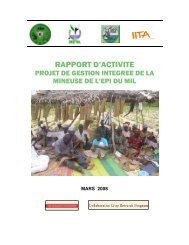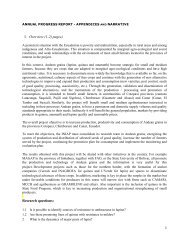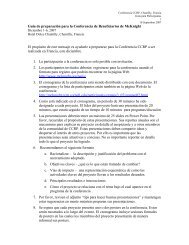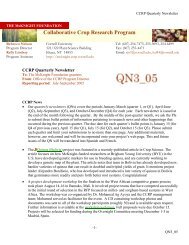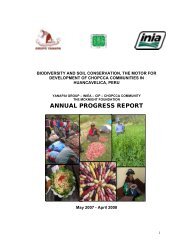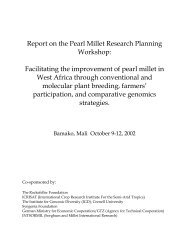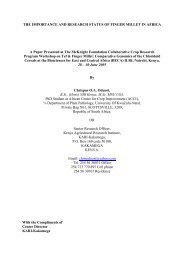English - McKnight Foundation Collaborative Crop Research Program
English - McKnight Foundation Collaborative Crop Research Program
English - McKnight Foundation Collaborative Crop Research Program
Create successful ePaper yourself
Turn your PDF publications into a flip-book with our unique Google optimized e-Paper software.
<strong>McKnight</strong> <strong>Foundation</strong> <strong>Collaborative</strong> <strong>Crop</strong>s <strong>Research</strong> Project No: 06-741<br />
This is the second season that the on farm evaluation of most promising lines of cowpea has been<br />
conducted in five villages namely; Msungua and Ikhanoda (Singida region), Kikombo (Dodoma region)<br />
and Mangalali and Mkungugu (Iringa region). Building from the 2008 evaluation, objectives of the 2009<br />
evaluation were as follow:<br />
~ To revisit the 2008 results<br />
~ To revisit evaluation criteria used in 2008<br />
~ To evaluate cowpea lines planted in 2009<br />
~ To make informed conclusion to guide for the subsequent on farm evaluation<br />
This brief presents the outcome evaluation of farmers’ trials in five villages in the above mentioned<br />
districts<br />
Method: The evaluation mission comprised Dr A.M. Mbwaga (Pathologist), Dr J.K. Mligo (Legume<br />
breeder) and Dr J.P. Hella (Agricultural Economist). As in 2008, the team participated in the on-farm<br />
evaluation in all villages for a period between 17 th and 24 th May 2009. In 2008 evaluation involved<br />
traversing with farmers in all five villages in each plot planted with a known variety of cowpea. Farmers<br />
were then requested to list, based on their own experience, the criteria which govern them to value and<br />
prefer particular varieties than another variety. Although main criteria varied across villages, but mostly<br />
hanged on high yield, early maturity, resistant to pests including Alectra, big sized seed and white to<br />
cream colour.<br />
Observations<br />
Criteria for selecting cowpea cultivar by villages in 2008<br />
Table 4 present the criterion used by farmers to rank different cowpea lines. The results were almost the<br />
similar in all villages. Good and more preferred lines are those associated with high yielding, early<br />
maturity, pest/disease (including Alectra) and drought resistant, large and white/cream seed colour.<br />
Table 4: Criteria for selecting different cowpea lines by village<br />
Msungua Ikhanoda Kikombo Mkungugu Mangalali<br />
Early maturity High yielding High yielding High yielding High yielding<br />
Resistance to Alectra, Early maturity Drought Large seeds Large seeds<br />
diseases/insects/pests<br />
resistance<br />
High yielding varieties<br />
with many leaves<br />
Cream color Early maturing Early maturity Early maturing<br />
Brown color Alectra Resistant to Tolerant to Alectra<br />
resistant Alectra Alectra tolerance<br />
Big size- seeds Big size seed Cream Seed Reddish seed Drought<br />
color<br />
colour<br />
resistance<br />
Large seeds Plenty green<br />
leaves<br />
Cowpea lines preferred by farmers in target villages 2008<br />
Based on criteria highlighted in Table 4 above, in May 2008, farmers evaluated 14 lines including the<br />
commercial released varieties i.e. Vuli-2 and Fahari and locally grown cultivars named by the respective<br />
village name. List of cowpea lines evaluated in 2008 is presented in Table 5 below:<br />
Table 5: List of cowpeas line planted and evaluated in 2008 season<br />
No Lines/cultivar<br />
1 IT 99K-7-21-2-2-1<br />
2 IT 99K-573-1-1<br />
3 IT 97K-499-8<br />
4 IT 97K-818-35<br />
5 IT 97K-819-118<br />
6 IT 97K-499-38<br />
7<br />
2009



